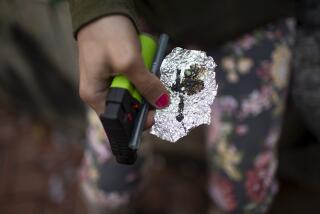In Eastern Oregon, ‘Going’ to School Means Living There
- Share via
CRANE, Ore. — Across the high desert of Oregon’s largest county, there are plenty of cattle, sheep and sagebrush. Range land seems to go on forever. People are few and far between, and schools are scarcer still.
Crane Union High School draws from an eastern Oregon territory that is roughly the size of New Jersey, Delaware and Rhode Island combined. Students talk about their commutes not in miles, but hours: two, three, four. . . .
That’s why the school boards nearly all of its 88 students during the week. It’s one of only a handful of public high schools nationwide that for reasons of sheer remoteness lodge their learners.
“You learn to deal with other people in the dorms. . . . You grow up earlier,” said senior Betsy Clark. “You know everybody, you know the teachers, you make longer and better friendships.”
Harney County, which stretches from east-central Oregon to the Nevada line, is ranch country, a patchwork of rugged spreads with names such as Roaring Springs and Double O. There are more than 100,000 head of beef cattle, but only 7,500 people.
This makes the act of going off to Crane for a high school education one of sacrifice for many families, who end up losing valuable ranch hands.
“My parents have to put in a lot of overtime,” said Joe Sherburn, a senior who has been making the two-hour trek every school week since he was 14.
Added Andrea Davies, who has two children at Crane: “The empty nest syndrome hits early here.”
But it is this rural atmosphere of sacrifice, hard work and family that makes Crane students a different breed. Most come from tiny, often one-room, schools scattered across the county’s 10,228 square miles.
“These kids were brought up on ranches, and they have a closer-knit home life,” said Dennis Mills, the county school superintendent. “It produces better-disciplined kids. They know what ‘no’ is. They don’t question authority.”
Vice principal and wood shop teacher Ed Goff wouldn’t exactly say big-city problems such as drugs are nonexistent, “but we have more trouble with chewing tobacco than we do with drugs.”
“Here you don’t worry about drugs or violence,” added Clark. “If that comes up, the teachers take care of it and it doesn’t happen anymore.”
The dorms have live-in adult chaperons and clearly spelled-out rules.
At 9:30 every night, the television in the lounge goes off, and an hour later the lights go out. Girls retire to their rooms upstairs, boys downstairs.
“And that’s it,” Principal James Haugen said emphatically, adding that boys caught upstairs are kicked out of the dorms.
Most students sleep two to a room that is small but not cramped. Some decorate the walls with pictures of family back home.
The dorms have no janitors. Students clean, mop, vacuum and scrub windows. They wash the dishes and haul the garbage.
It may be a no-frills life, but ever since Crane became a boarding school in 1931 it’s been free to kids within the district. Many nearby districts without high schools pay some or all of the $2,500 a year that covers room and board for outsiders.
About 65 of the 88 students at Crane live in the dorms and go home most weekends.
When Haugen arrived three years ago, he brought a no-nonsense style.
Parental permission is required for students to leave campus. Previously, the principal said, “kids were jumping in their cars and saying they were heading off somewhere that sounded legitimate when it turned out that they weren’t.”
He also took the televisions and VCRs out of the dorm rooms, which eliminated the late-night video games. There were howls of indignation, he recalled. But lists of those with “U” or unsatisfactory grades went from long to short.
“If kids want to succeed, they can here,” said Linda Bennett, a counselor, curriculum director and Spanish teacher. “We have better control of the kids with the dorm. We can call over and say, ‘I want you in my room now.”’
The U list comes out weekly. Students on it must spend extra evenings in the computer lab or with a teacher. Failing students are barred from extracurricular activities for that week.
That’s a severe sanction in a school where almost everyone participates in a sport, and athletics are about the only diversion.
“Sometimes if a student can be doing A work and is getting a C I’ll put him on the U list because he is not working up to ability,” Bennett said. “A lot of other teachers feel the same way.”
Freshman Tony Berrett said he finds even Crane too crowded. He hopes to return to his family’s 7,800 acres of hay and range land and eventually run it.
As he practiced a technique in welding class, instructor Don Bennett corrected him.
“I like doing it this way,” Berrett protested.
“Back on the farm I don’t care how you do it, but in my shop you’ll do it like I tell you,” Bennett said.
The boy obeyed.
On a given day, Crane students may be upgrading and reassembling computers for use in the district or be in a ditch doing soil analyses with agricultural teacher Dave Courtney, who also teaches science and coaches the eight-member football team.
He interrupted football practice twice last year so the team could help fight range fires.
“Here, kids build a respect for their teachers and the work that needs to get done,” Courtney said. “They know that if you don’t do it out here, you do without. It gives us a better student to work with.”
More to Read
Sign up for Essential California
The most important California stories and recommendations in your inbox every morning.
You may occasionally receive promotional content from the Los Angeles Times.













